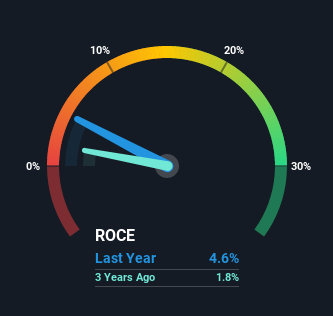Here's What's Concerning About IntraSoft Technologies' (NSE:ISFT) Returns On Capital
If we want to find a stock that could multiply over the long term, what are the underlying trends we should look for? One common approach is to try and find a company with returns on capital employed (ROCE) that are increasing, in conjunction with a growing amount of capital employed. Ultimately, this demonstrates that it's a business that is reinvesting profits at increasing rates of return. Although, when we looked at IntraSoft Technologies (NSE:ISFT), it didn't seem to tick all of these boxes.
What is Return On Capital Employed (ROCE)?
For those who don't know, ROCE is a measure of a company's yearly pre-tax profit (its return), relative to the capital employed in the business. To calculate this metric for IntraSoft Technologies, this is the formula:
Return on Capital Employed = Earnings Before Interest and Tax (EBIT) ÷ (Total Assets - Current Liabilities)
0.046 = ₹124m ÷ (₹3.0b - ₹350m) (Based on the trailing twelve months to December 2021).
Therefore, IntraSoft Technologies has an ROCE of 4.6%. On its own that's a low return on capital but it's in line with the industry's average returns of 4.7%.
View our latest analysis for IntraSoft Technologies

Historical performance is a great place to start when researching a stock so above you can see the gauge for IntraSoft Technologies' ROCE against it's prior returns. If you want to delve into the historical earnings, revenue and cash flow of IntraSoft Technologies, check out these free graphs here.
How Are Returns Trending?
In terms of IntraSoft Technologies' historical ROCE movements, the trend isn't fantastic. Over the last five years, returns on capital have decreased to 4.6% from 8.7% five years ago. Given the business is employing more capital while revenue has slipped, this is a bit concerning. This could mean that the business is losing its competitive advantage or market share, because while more money is being put into ventures, it's actually producing a lower return - "less bang for their buck" per se.
On a side note, IntraSoft Technologies has done well to pay down its current liabilities to 11% of total assets. That could partly explain why the ROCE has dropped. What's more, this can reduce some aspects of risk to the business because now the company's suppliers or short-term creditors are funding less of its operations. Some would claim this reduces the business' efficiency at generating ROCE since it is now funding more of the operations with its own money.
The Key Takeaway
In summary, we're somewhat concerned by IntraSoft Technologies' diminishing returns on increasing amounts of capital. It should come as no surprise then that the stock has fallen 42% over the last five years, so it looks like investors are recognizing these changes. That being the case, unless the underlying trends revert to a more positive trajectory, we'd consider looking elsewhere.
Since virtually every company faces some risks, it's worth knowing what they are, and we've spotted 5 warning signs for IntraSoft Technologies (of which 1 is potentially serious!) that you should know about.
While IntraSoft Technologies may not currently earn the highest returns, we've compiled a list of companies that currently earn more than 25% return on equity. Check out this free list here.
New: AI Stock Screener & Alerts
Our new AI Stock Screener scans the market every day to uncover opportunities.
• Dividend Powerhouses (3%+ Yield)
• Undervalued Small Caps with Insider Buying
• High growth Tech and AI Companies
Or build your own from over 50 metrics.
Have feedback on this article? Concerned about the content? Get in touch with us directly. Alternatively, email editorial-team (at) simplywallst.com.
This article by Simply Wall St is general in nature. We provide commentary based on historical data and analyst forecasts only using an unbiased methodology and our articles are not intended to be financial advice. It does not constitute a recommendation to buy or sell any stock, and does not take account of your objectives, or your financial situation. We aim to bring you long-term focused analysis driven by fundamental data. Note that our analysis may not factor in the latest price-sensitive company announcements or qualitative material. Simply Wall St has no position in any stocks mentioned.
About NSEI:ISFT
IntraSoft Technologies
Through its subsidiaries, engages in the development and delivery of e-commerce and e-cards through internet platform in India and internationally.
Flawless balance sheet and good value.
Market Insights
Community Narratives




